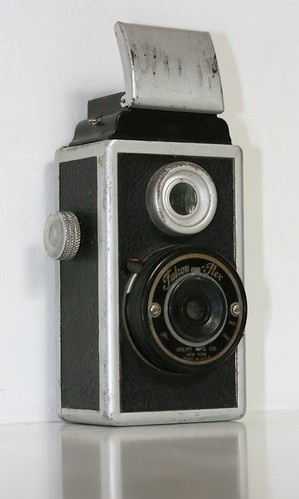Difference between revisions of "Falcon Flex"
m (long-form footnote) |
(→Notes) |
||
| Line 36: | Line 36: | ||
[[Category: F]] | [[Category: F]] | ||
[[Category: 127 film]] | [[Category: 127 film]] | ||
| + | The Falcon Flex 6x6 model was manufactured in 1939. It was made in New York, New York by the Utility Mfg. Company which may have been located at West 25th Street. This Falcon Flex is made of cast aluminum and has a bakelite hood. The camera features a focusing taking lens marked at 6ft and infiniti. It has a single speed shutter with B setting, adjustable aperture with settings for f-11 and f-16, and a Faltar Precise 82mm lens. It is covered in black fine grain leatherette which is embossed with lines along its borders. The earlier model of this camera has three red windows on the back panel in a row down the left side, while the later variant had one red window in the center of the back panel. Both models took 120 film, and may have been some of the first American made twin lens cameras. | ||
Revision as of 18:16, 28 December 2012
The Falcon Flex 3x4 was a 127 film pseudo TLR made by the Utility Manufacturing Company in New York. The body was cast in aluminium[1].

|
| Falcon Flex image by Graustark (Image rights) |

|
| Falcon Flex image by Graustark (Image rights) |
The Falcon Flex 6x6 was a 120 film version, c.1939.

|
| 6×6 Falcon Flex image by Billy Cox (Image rights) |
Notes
- ↑ McKeown, James M. and Joan C. McKeown's Price Guide to Antique and Classic Cameras, 12th Edition, 2005-2006. USA, Centennial Photo Service, 2004. ISBN 0-931838-40-1 (hardcover). ISBN 0-931838-41-X (softcover). Page 943.
The Falcon Flex 6x6 model was manufactured in 1939. It was made in New York, New York by the Utility Mfg. Company which may have been located at West 25th Street. This Falcon Flex is made of cast aluminum and has a bakelite hood. The camera features a focusing taking lens marked at 6ft and infiniti. It has a single speed shutter with B setting, adjustable aperture with settings for f-11 and f-16, and a Faltar Precise 82mm lens. It is covered in black fine grain leatherette which is embossed with lines along its borders. The earlier model of this camera has three red windows on the back panel in a row down the left side, while the later variant had one red window in the center of the back panel. Both models took 120 film, and may have been some of the first American made twin lens cameras.